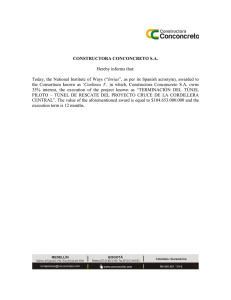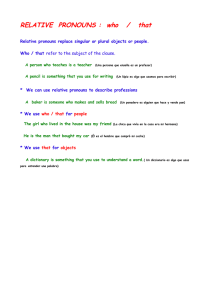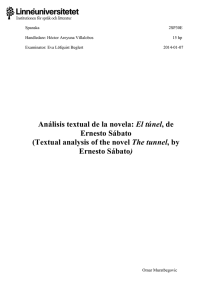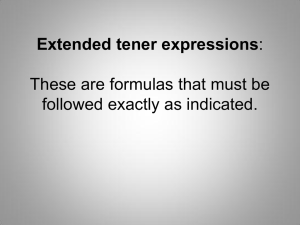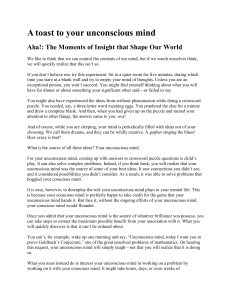full text - Armand F. Baker
Anuncio
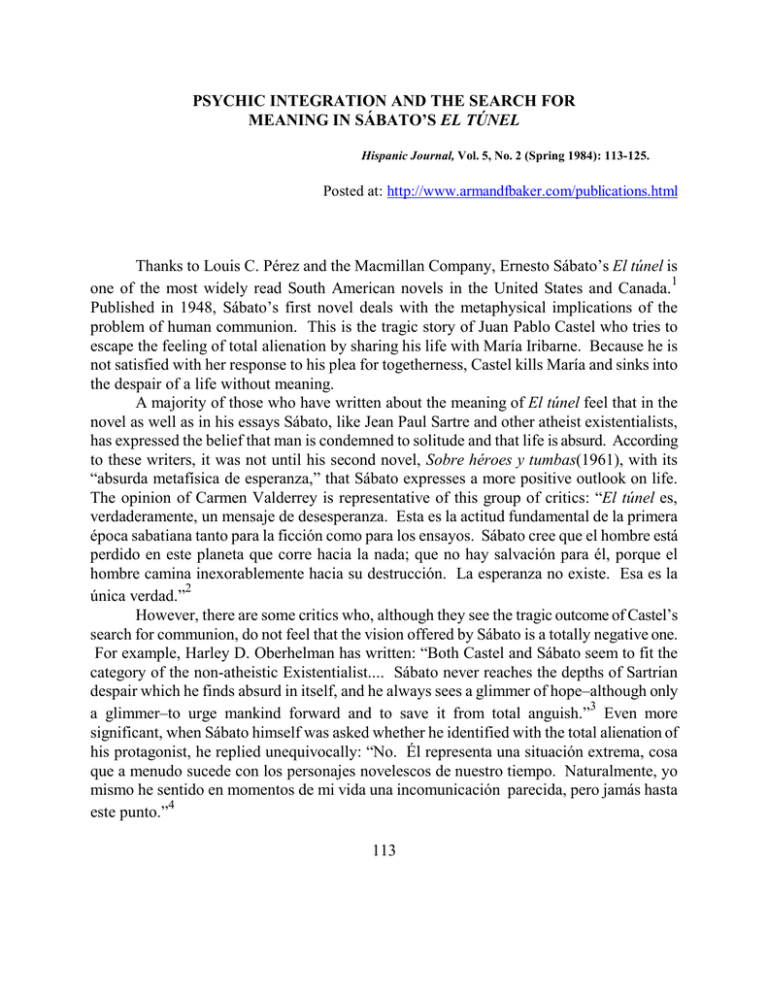
PSYCHIC INTEGRATION AND THE SEARCH FOR MEANING IN SÁBATO’S EL TÚNEL Hispanic Journal, Vol. 5, No. 2 (Spring 1984): 113-125. Posted at: http://www.armandfbaker.com/publications.html Thanks to Louis C. Pérez and the Macmillan Company, Ernesto Sábato’s El túnel is 1 one of the most widely read South American novels in the United States and Canada. Published in 1948, Sábato’s first novel deals with the metaphysical implications of the problem of human communion. This is the tragic story of Juan Pablo Castel who tries to escape the feeling of total alienation by sharing his life with María Iribarne. Because he is not satisfied with her response to his plea for togetherness, Castel kills María and sinks into the despair of a life without meaning. A majority of those who have written about the meaning of El túnel feel that in the novel as well as in his essays Sábato, like Jean Paul Sartre and other atheist existentialists, has expressed the belief that man is condemned to solitude and that life is absurd. According to these writers, it was not until his second novel, Sobre héroes y tumbas(1961), with its “absurda metafísica de esperanza,” that Sábato expresses a more positive outlook on life. The opinion of Carmen Valderrey is representative of this group of critics: “El túnel es, verdaderamente, un mensaje de desesperanza. Esta es la actitud fundamental de la primera época sabatiana tanto para la ficción como para los ensayos. Sábato cree que el hombre está perdido en este planeta que corre hacia la nada; que no hay salvación para él, porque el hombre camina inexorablemente hacia su destrucción. La esperanza no existe. Esa es la 2 única verdad.” However, there are some critics who, although they see the tragic outcome of Castel’s search for communion, do not feel that the vision offered by Sábato is a totally negative one. For example, Harley D. Oberhelman has written: “Both Castel and Sábato seem to fit the category of the non-atheistic Existentialist.... Sábato never reaches the depths of Sartrian despair which he finds absurd in itself, and he always sees a glimmer of hope–although only 3 a glimmer–to urge mankind forward and to save it from total anguish.” Even more significant, when Sábato himself was asked whether he identified with the total alienation of his protagonist, he replied unequivocally: “No. Él representa una situación extrema, cosa que a menudo sucede con los personajes novelescos de nuestro tiempo. Naturalmente, yo mismo he sentido en momentos de mi vida una incomunicación parecida, pero jamás hasta 4 este punto.” 113 114 HISPANIC JOURNAL In view of this fundamental disagreement with regard to the meaning of El túnel, it is appropriate to re-examine some of the things that Sábato has had to say, not only in this novel, but in the essays as well. In doing so it is my hope that I will be able to show that, despite the tragic conclusion of his first novel, Sábato has had some very positive things to say about the problem of communion and the meaning of life. I will examine the psychic disposition of the three main characters (Castel, María and Allende) from a Jungian 5 perspective, with the assumption that a person’s psychic balance, or lack of it, has a direct bearing on the success of his or her relations with others, as well as his or her metaphysical outlook on life. One of the primary concerns of C. G. Jung was the establishment of a dynamic balance between the different levels of the psyche, a balance which allows the person to complete a process of psychological development that leads to what he calls “individuation.” This is the process by which a person becomes the definite, unique being he or she in fact is, 6 and can be described as “coming to selfhood,” or as “self-realization.” The aim of individuation is to divest the self of the artificial trappings of the persona–the false personality which “masks” the true individual–and at the same time to free the self from the suggestive power of the collective unconscious. Individuation aims, therefore, at the living cooperation of the individual and the collective, of the conscious and the unconscious, and is an indispensable step toward what Jung sees as the supreme goal of all human existence: to become conscious of the contents of that press upward from the unconscious and, thus, to create more and more consciousness. A development of this kind, however, does not always run smoothly for the simple reason that civilized man tends to ignore the unconscious. Jung feels that one of the most important factors which work against a proper recognition of unconscious contents is the tendency to believe only in what is rational. The use of reason is undoubtedly a virtue and an advantage, but it can become a limitation and an impoverishment when carried to an extreme. This is because reason emits a deceptive light which illuminates only what we know already and spreads a darkness over all those things which would be most useful to our consciousness. As Jung explains: “Reason sets the boundaries far too narrowly for us, and would have us accept only the known–and that too with limitations–and live in a known framework, just as if we were sure how far life actually extends. As a matter of fact, day after day we live far beyond the bounds of our consciousness; without our knowledge, the life of the unconscious is also going on within us. The more critical reason dominates, the more impoverished life becomes.” This is not to advocate pure irrationalism; what is needed rather is a working balance between the rational and the intuitive aspects of the psyche, or as Jung states: “We cannot and ought not to repudiate reason; but equally we must cling to the 7 hope that instinct will hasten to our aid.” Anyone who has read the work of Ernesto Sábato is aware that he is very SÁBATO’S EL TÚNEL 115 well informed about modern psychology, and that many of his ideas are identical to those of Jung. Jung’s name appears several times in each of the essays, and on more than one occasion Sábato mentions the Jungian theory of the anima and the animus as he discusses the bisexual aspect of the self. Sábato has frequently spoken of the limits of reason, and he has also insisted on the need to create a balanced self. Since these ideas are found in his essays, 8 it is only to be expected that they will also have an important place in his works of fiction. As we begin our study of El túnel, let us look first at the protagonist, Juan Pablo Castel. In spite of the fact that Castel is an artist whose intuitive powers should allow him to bridge the gap between the different parts of his psyche, the reader soon becomes aware that Castel has identified exclusively with his conscious self, and in so doing has repressed the 9 unconscious. This is because he sees the unconscious as a repository for all that is ugly and reprehensible in human nature. This negative attitude toward the inner self is evident when he refers to the unconscious as “una especie de inmunda cueva” (p. 60), and in the thoughts that invade his consciousness when María has finally explained her feelings about his painting: “Sombrios pensamientos se movían en la oscuridad de mi cabeza, como en un sótano pantanoso; esperaban el momento de salir, chapoteando, gruñiendo sordamente en el barro” (p. 78). It is this dark aspect of his psyche which also causes him to fear the painting which is the symbolic description of his own unconscious: “Esa escena de la playa me da miedo.... No es un mensaje claro, todavía, pero me representa profundamente a mí” (p. 33). In addition to what he says about self-realization, Jung rejects the negative definition of the unconscious which has resulted from Freud’s theories of sexual repression. He also speaks very clearly about the need to assimilate the contents of the unconscious into the conscious mind, and of the dangerous consequences which follow when this does not occur: “The unconscious is not a demonic monster, but a thing of nature which is perfectly neutral as far as moral sense, aesthetic taste and intellectual judgment go. It is dangerous only when our conscious attitude towards it becomes hopelessly false. And this danger grows in the measure that we practice repressions. But as soon as the patient begins to assimilate the contents that were previously unconscious, the danger from the side of the unconscious diminishes. As the process of assimilation goes on, it puts an end to the dissociation of the personality and to the anxiety that attends and inspires the separation of the two realms of the 10 psyche.” It is precisely this separation of the psyche, together with the dissociation and the anxiety caused by the repression of the unconscious, which now becomes the most important factor in our continued study of Juan Pablo Castel. As we have seen, Castel’s main goal in life is to escape from the prison of his aloneness and become one with another human being. However, those who have written about El túnel have not always seen the fundamental cause of this intense desire for communion. Sábato himself has explained that “El derrumbe del orden establecido y la 116 HISPANIC JOURNAL consecuente crisis del optimismo.... convierte al tema de la soledad en el más tremendo de la literatura contemporánea” (El escritor y sus fantasmas, p. 88). And precisely because he has participated in this “crisis of optimism,” Castel has serious doubts about the meaning of life– “A veces creo que nada tiene sentido”–which lead him to question the entire purpose of human existence: “En un planeta minúsculo, que corre hacia la nada desde millones de años, nacemos en medio de dolores, crecemos, luchamos, nos enfermamos, sufrimos, hacemos sufrir, gritamos, morimos, mueren y otros están naciento para volver a empezar la comedia inútil. ¿Sería eso verdaderamente? Me quedé reflexionando en la falta de sentido. ¿Toda nuestra vida sería una serie de gritos anónimos en un desierto de astros indiferentes?” (pp. 32-33). Here we have the central metaphysical conflict of the novel. In this key passage a direct relationship is established between meaning and communion; Castel feels that if man is fundamentally alone, life has no purpose; but if communion is possible, life cannot be 11 totally without meaning. At this point in our discussion the crucial factor becomes the method which Castel uses to establish communion with María, and we see that he chooses one that is in harmony with what has already been said of his character. Since Castel has developed such a negative attitude toward the unconscious, his modus operandi will inevitably be a product of conscious thought. In another discussion of the person who represses the contents of the unconscious, Jung describes a type of behavior which can also be seen in the actions of Castel: “If the primordial images remain conscious in some form or other, the energy that belongs to them can flow freely into man. But when it is no longer possible to maintain contact with them, the tremendous energy stored up in these images..., falls back into the unconscious. The unconscious then becomes charged with a force that acts as an irresistible vis a tergo to whatever view or idea or tendency our intellect may choose to dangle before our desiring eyes. In this way man is delivered over to his conscious side, and reason 12 becomes the arbiter of right and wrong, of good and evil.” Just as in the situation which Jung describes, Castel becomes a victim of his own intellect which has decided that everything in life must have a rational explanation. Like the insane protagonist of Hunter’s theoretical detective novel, he is consumed by the need to rationalize his entire existence: “¿Acaso no no razonaba? Por el contrario, mi cerebro estaba constantemente razonando, como una máquina de calcular” (pp. 30-31). He is convinced, moreover, that this rational way of thinking is necessary to prove that he and María are truly one. For this reason, he subjects Maria to a series of relentless interrogations in an attempt to obtain concrete proof of her feelings for him: “Necesitaba detalles: me emocionan los detalles, no las generalidades” (p. 35). And it is also this same mania for absolute proof that makes him desire to have a physical relationship with María: “De modo que la unión física me aparecía SÁBATO’S EL TÚNEL 117 como una garantía de verdadero amor” (p. 50). In spite of Castel’s insistence on reason, however, the reader is increasingly aware that, far from producing communion, his ultra-rational conduct is having the opposite 13 effect. Although he insists that his capacity for logical thought has helped him establish a relationship with María (p. 31), this is obviously not the case, since his elaborate plans for their first meeting only ended in confusion, and since it was María who actually initiated the relationship after he fled in embarrassment. Furthermore, whenever Castel tries to force María to reveal her thoughts, he destroys her freedom by converting her into an object, making it impossible for them to relate as equals. There are many points in the novel where Castel fails to establish communion through rational means, but this is never more obvious than on the occasion of their meeting when María returns from her first trip to the country. It is after dark when María arrives, and Castel immediately begins to question her about her husband and about her unexpected trip to the country. Since she does not reply, he lights a match in order to see her face. In this scene, as well as in other parts of the novel, the image of light, with its power to reveal the concrete forms of physical reality, is associated with rational consciousness. In line with his belief that communion can be produced through rational means, Castel associates communion with light; and darkness, which deprives him of the opportunity for visual contact is equated with separation and lack of communion. Keeping this in mind, let us examine this key episode in more detail: Desesperado por el silencio y por la oscuridad que no me permitía adivinar sus pensamientos a través de sus ojos, encendí un fósforo. Ella dio vuelta rápidamente la cara, escondiéndola. Le tomé la cara con mi otra mano y la olbligué a mirarme: estaba llorando silenciosamente. –Ah... Entonces no me quieres–dije con amargura. Mientras el fósforo se apagaba vi, sin embargo, cómo me miraba con ternura. Luego, ya en plena oscuridad, sentí que su mano acariciaba mi cabeza. Me dijo suavemente: –Claro que te quiero... ¿por qué hay que decir ciertas cosas? –Sí–le respondí– ¿pero cómo me quieres? Hay muchas maneras de querer. Se puede querer también a un perro, a un chiquillo. Yo quiero decir amor, verdadero amor, ¿entiendes? Tuve una rara intuición: encendí rápidamente otro fósforo.... (p. 47). When Castel lights the match and forces María to look at him, he is obeying that aspect of his character which makes him search for rational proof of communion; when he sees her face, he concludes that Maria does not love him. However as the light begins to disappear, he discerns an expression of tenderness on her face and, in complete darkness, María 118 HISPANIC JOURNAL touches him and says: “Of course I love you.” Because his mania for rational proof causes him to limit his awareness to what the light can reveal, Castel fails to sense the delicate 14 feeling of oneness which permeates this moment of darkness. Unable or unwilling to accept the subtle emotions which María offers him when she is allowed to express her true feelings, Castel lights another match which immediately destroys the fragile moment of togetherness. In this scene we have a perfect example of the process which operates throughout the entire novel: Castel’s attempt to force his relations with María into a rigid system of rational absolutes causes him to miss the opportunity for oneness which was his most important goal in life. As Fred Petersen has put it: “The final and crashing irony of the book is that Castel is so preoccupied with his own reasoning that he fails to see that he has 15 achieved his goal of communication.” Like all emotions and intuitions, the feeling of communion is something which is experienced in a state of non-rational awareness. Although it is a form of psychic reality which anyone can observe, it cannot be verified intellectually and therefore appears as something which, from a strictly rational point of view, is essentially unreal. Nevertheless, as we have seen in the incident of the matches, the lack of rational proof does not mean that communion does not occur. This explains why in certain parts of the novel Castel says that he had experienced “algunos momentos de comunión” with María, but in the end his intellect has convinced him of the contrary (p. 97). Therefore, his total isolation at the conclusion of the novel is not caused by the fact that communion is impossible, but by his own insistence on reason, which made him strive to possess María in an absolute sense. Castel seems to catch a rare, intuitive glimpse of this fact when he declares: “Siento que, en cierto modo, estoy pagando la insensatez de no haberme conformado con la parte de María que me salvó (momentáneamente) de la soledad. Ese estremecimiento de orgullo, ese deseo creciente de posesión exclusiva debían haberme revelado que iba por mal camino...” (p. 74); and again moments later he reiterates: “Más que nunca, sentía que jamás llegaría a unirme con ella en forma total y que debía resignarme a tener frágiles momentos de comunión...” (p. 75). Thus, El túnel does not express the notion that man is essentially alone in life; on the contrary, it shows that Castel’s failure is a result of his lack of pshycic integration, which causes him to over-emphasize the importance of reason in his relations with María. Those critics who have seen a parallel between the ideas of Juan Pablo Castel and those of Jean Paul Sartre–the similarity of their names is not a coincidence–are correct. I have tried to show, however, that they are mistaken when they attribute Castel’s ideas to Sábato himself. These critics also do not take into account what Sábato has said in his essays, where he criticizes Sartre because he suffers from the same fundamental defect SÁBATO’S EL TÚNEL 119 16 –excessive rationalism–which plagued Castel. In his essays Sábato also makes it clear that, although it is difficult to achieve and impossible to prolong, communion does exist for those who are able to love with their entire being. He expresses this idea on several occasions: in his essay “Sobre la metafísica del sexo” he writes: “Lo único que puede salvar de la angustia sexual es el amor pleno, a 17 través de todos sus estratos: del fisiológico, del psicológico, del espiritual”; on another occasion he reiterates: “Solamente mediante la plena relación con un sujeto (cuerpo y alma), podremos salir de nosotros mismos, trascender nuestra soledad y lograr la comunicación” (Heterodoxia, p. 56); and in a more recent essay he declares once more: “Sólo la plena relación con el otro yo permite salir de uno mismo, trascender la estrecha cárcel del propio cuerpo y, a través de su carne y de la carne del otro (maravillosa paradoja) alcanzar su propia alma” (El escritor y sus fantasmas, p. 174). Finally, in Hombres y engranajes Sábato not only declares that communion exists, but he also afirms that this fact is enough to give life meaning: “No estamos completamente aislados. Los fugaces instantes de comunidad ante la belleza que experimentamos alguna vez al lado de otros hombres, los momentos de solidaridad ante el dolor, son como frágiles y transitorios puentes que comunican a los hombres por sobre el abismo sin fondo de la soledad. Frágiles y transitorios, esos puentes sin embargo existen y aunque se pusiese en duda todo lo demás, eso debería bastarnos para saber que hay also fuera de nuestra cárcel y que ese algo 18 es valioso y da sentido a nuestra vida, y tal vez hasta un sentido absoluto.” A study of what happens to María and Allende will not add anything essentially new to what we have already learned from our study of Castel. But an examination of their function in the novel can serve to further reinforce as well as clarify what has been said about the relationship between psychic integration and the search for meaning. Since María’s blind husband, Allende, represents a type of person who in many ways is the opposite of Castel, let us proceed with an examination of his character. While Castel always strives to live in a world which is illuminated by rational consciousness, Allende’s lack of vision symbolizes a psychic disposition which is in harmony with the dark world of the unconscious. There are several things that attest to this fact, one of which is the manner in which he reacts when he meets Castel for the first time. As he hands Castel a letter from Maria, Allende expresses his confidence that its contents will be of little importance. In an effort to explain, he continues: “–Así es María– dijo, como pensndo para sí–. Muchos confunden sus impulsos con urgencias. María hace, efectivamente, con rapidez, cosas que no cambian la situación. ¿Cómo le explicaré? ... Como alguien que estuviera parado en un desierto y de pronto cambiase de lugar con gran rapidez. ¿Comprende? La velocidad no importa, siempre se está en el mismo paisaje” (p. 39). Those critics who have mentioned this passage have seen it only as a description of María, without realizing that its true significance is that it shows us a great deal about 120 HISPANIC JOURNAL Allende’s own outlook on life. These are the words of a person who believes that life is essentially unknowable, and that all conscious, objective efforts to influence it are 19 futile. Because he does not try to find a rational explanation for María’s actions, Allende is satisfied with the limits of their relationship. For this reason he avoids the tragic error–the insensatez–of Castel, and he does not try to achieve total possession of María. María states that one of the things she admired in her husband was “la serenidad de su espíritu” (p. 58), and it is clear that this inner serenity results from the fact that Allende does not ask from life more than life can give. In the final analysis, however, Allende’s calm detachment from the objective world 20 of reason does not permit him to achieve an integrated self. If Castel is wrong in limiting himself to consciousness, it is equally unwise for Allende to go to the opposite extreme and to identify himself with the unconscious. The definitive proof of Allende’s lack of balance is his violent reaction and eventual suicide when Castel tells him of Maria’s relationship with Hunter and himself. The blind Allende has tried to ignore the world of conscious reality; but in the end Castel forces him to “see,” and since he has chosen to deny the rational point of view, he has no way to defend himself against the “logic” of Castel. Although they have lived at opposite poles of the psyche, both Castel and Allende have ignored the total self, and it is their failure to establish a balance that finally brings about their destruction. And that leaves María, the only character of the novel who has achieved a state of psychic integration. Richard Callan and Robert H. Scott have both observed that, from Castel’s point of view, María is a projection of his own unconscious–his anima. Castel himself confirms this fact when he states that there is something familiar about María, as if he had always known her–“me recordaba algo que no podía precisar”–and he adds that she has become the impersonal symbol of his own need for feminine companionship: “Sentía que el amor anónimo que yo había alimentado durante años de solidad se había concentrado en Maria” (p. 43). But even more noteworthy is the fact that in spite of her relative youth María seems to be older and more mature than Castel. Fred Peterson has stated that for him María is “la más >normal,’ la menos alterada, la personalidad más 21 completa de toda la novela”; and María Angélica Correa also feels that in comparison 22 with Sábato’s masculine characters “ella se muestra más fuerte, vitalmente más rica.” In his essays Sábato corroborates this point of view when he states that the characters of El túnel embody different facets of his own being, and while Castel represents the side of him which is “adolescente y absolutista,” María represents a side of which is “maduro y relativizado” (El escritor y sus fantasmas p. 13). Although we know much less of María than of Castel, what we are able to observe, based on her actions in the novel, confirms that she is in fact a person who 23 has achieved something of a balance between the conscious and the unconscious. By her SÁBATO’S EL TÚNEL 121 own admission (p. 77), she is also consciously searching for another person who can share her solitude, which indicates that she does not hold Allende’s opinion about the futility of all concrete action in the exterior world of objective reality. Nor does she agree with Castel’s desire to find a rational explanation for everything that exists, as she declares emphatically during one of his interrogations: “Esta conversación es absurda.... Todo esto es una tontería. Me asombra que te preocupes de cosas así” (p. 49). And since her intuitive, feminine nature allows her to be more receptive to the messages of the unconscious, she has no need of the concrete proofs which are so important for Castel’s superrational nature: “¿Por qué todo ha de tener respuesta?” she asks Castel just before the episode of the matches; and again she exclaims: “¿Por qué hay que decir ciertas cosas?” (p. 47). The positive element in this otherwise totally pessimistic novel, therefore is represented by María. Although she is destroyed by the same exaggerated rationalism that destroys Allende and Castel himself, her more balanced, feminine nature is an example of what Sábato sees as the only hope for the future of humanity. In today’s predominantly masculine society, the feminine element of human nature has been relegated to a position of inferiority. For this reason it is important to restore the balance of the collective psyche by creating a greater awareness of the feminine characteristics which we all possess. In his essay “Sobre la metafísica del sexo,” Sábato explains this point in some detail: La sociedad moderna virilizó a la mujer, falsificando, con graves consecuencias psíquicas, la esencia de su ser.... Si es que la radical crisis de nuestro tiempo ha de ser superada, habrá que volver a la mujer femenina, pero eso implica que a su vez el hombre ha de realizar una síntesis de las antítesis que ha creado. Se ha de volver a lo concreto sin desdeñar la abstracción, se ha de integrar la lógica y la vida, el objeto con el sujeto, la esencia con la existencia. En otras palabras, habrá que femenizar la sociedad.... El hombre con la mujer puede realizar las hazañas más portentosas; pero el hombre solo llega finalmente a la nada de la abstracción sin salida. Hay que retornar a la mujer porque ella es quien representa la unidad en todos los sentidos (p. 45). The type of person who is best suited to the task of helping us move in the direction of a greater femininity is the artist, who is in touch with the creative impulses of his unconscious self: “El artista resultaría así una fusión de hombre y mujer, de conciencia y razón viriles y de inconciencia e intuición femeninas” (“Sobre la metafísica del sexo,” p. 45). In Hombres y engranajes Sábato again expresses his hope for a synthesis of the opposite poles of human nature which will lead to a more balanced society: “El hombre debe luchar hoy por una nueva síntesis: no una mera resurrección del individualismo, sino 122 HISPANIC JOURNAL la conciliación del individuo con la comunidad; no el destierro de la razón y de la máquina sino su reglamento a los estrictos territorios que le corresponden” (pp. 113-114). And in this same book he comments directly on the ideas we have just examined in El túnel. As he discusses the philosophy of Jean Paul Sartre which has made such a strong impression on our time, Sábato points out that atheist existentialism leads to a denial of all human values since these values sooner or later are anulled by death. He then observes that those who have accepted this fundamentally nihilistic doctrine have no reason to keep on living if all is ultimately for naught. Dissatisfied with this negative point of view, he states that perhaps it would be more logical to invert our perspective; perhaps we should not ask why we keep on living if life has no meaning, but rather suspect that life must have meaning since, in spite of everything, most of us keep on struggling to stay alive. Then, flatly contradicting those who have stated that during his early years he was totally without hope, Sábato concludes with an optimistic statement of faith in life which even leaves room for the possibility of life after death, and for the possible existence of a Supreme Being who will help us in our fight against evil. Referring once again to the fact that humanity keeps on struggling to survive, he writes: “Esto debería bastar para probarnos que el mundo tiene algún misterioso sentido y para convencernos de que, aunque mortales y perversos, los hombres podemos alcanzar de algún modo la grandeza y la eternidad. Y que, si es cierto que Satanás es el amo de la tierra, en alguna parte del cielo o en algún rincón de nuestro ser reside un Espíritu Divino que incesantemente lucha contra él, para levantarnos una y otra vez sobre el barro de nuestra desesperación” (Hombres y engranajes, pp. 120-121). Although Sábato’s later novels paint a picture of life which is extremely bleak, these works also contain an expression of hope that humanity will some day enter a new era of greater spiritual awareness. Thirty years ago Sábato remarked: “Nuestro tiempo es el de la desesperación y de la angustia, pero paradojalmente, sólo así puede abrirse la puerta de una nueva y auténtica esperanza” 106-107). With this statement–that the human race must reach rock bottom before it begins its climb to the heights–Sábato laid the foundation for his apocalyptic novel Abbadón, el extermindor. This entire novel is based on the idea that humanity must endure the purifying effect of passing through a period of suffering and moral degradation, which will be accompanied by the birth of a new awareness, as Sábato has stated in the following passage: “Estamos en el umbral de una nueva edad. Sufriremos toda clase de arbitrariedades, crímenes e injusticias. Habrá nuevas hogueras. Vano esfuerzo. La era de la Tecnología Moral ha comenzado. Como hace millones de años, otros ojos están 24 abriéndose paso entre los huesos del cráneo.” As we leave the Age of Pices and enter the Age of Aquarius, Sábato joins the ranks of those who feel that a change in our way of living is inevitable. And if the destructive urge of today’s masculine society does not give way in time to the gentler feminine spirit SÁBATO’S EL TÚNEL 123 which is also part–perhaps the most important part–of human nature, this new age may be ushered in by a period of global violence. Thus it is that Sábato’s most recent novel expresses again the anguish, and the hope, that were also implicit in his earliest novel, El túnel. State University of New York at Albany Armand F. Baker Posted at: http://www.armandfbaker.com/publications.html NOTES 1 As of this writing the Macmillan Company Edition of El túnel edited by Louis C. Pérez, which appeared in 1965, is in its 20th printing. Since it is the most readily available in this country, all quotations from the novel will be taken from this edition. 2 Carmen Valderrey, “La búsqueda del absoluto en la narrativa de Ernesto Sábato,” Arbor, 87, No. 340 (1974), p. 113. Other critics who offer a similar interpretation of the meaning of El túnel are Marcelo Coddou, María Angélica Corea, Helmy Giacomán, Tamara Holzapfel, Juan Isidro Jiménes Grullón, Rudolf Kohler, and Thomas C. Meehan. 3 Harley D. Oberhelman, Ernesto Sábato (New York: Twayne Series, 1970), p. 56. Those writers who offer a more positive interpretation of El túnel in that they attribute Castel’s failure to communicate to his own shortcomings, rather than the belief that communion is impossible, include Beverly J. Gibbs, Nathan T. Francis and William F. Adams, Fred Peterson, Henry J. Richards and Robert H. Scott. 4 El escritor y sus fantasmas (Buenos Aires: Aguilar, 1963), p. 13. 5 I am especially indebted to Richard J. Callan and Robert H. Scott whose efforts to examine certain elements of Sábato’s writing from a Jungian point of view have been very helpful in the elaboration of the present study. See Richard J. Callan, “Sábato’s Fiction: A Jungian Interpretation,” Bulletin of Hispanic Studies, 51, No. 1 (1974), pp. 48-59; and Robert H. Scott, “El túnel: The Novel as a Psychic Drama,” The American Hispanist, 14, No. 2 (1977), pp 13-15. For a discussion of the use of psychological theory in literary analysis, see C. G. Jung, “Psychology and Literature,” in Modern Man in Search of a Soul (New York: Harcourt, Brace, Jovanovich, 1933), pp. 152-172. 6 C. G. Jung, “Relations Between the Ego and the Unconscious,” in The Portable Jung (New York: Viking Press, 1974), pp. 122-123. 7 Memories, Dreams, Reflections (New York: Vintage Books, 1965), pp. 302, 341. 8 In an autobiographical section of his latest novel, Abbadón, el exterminador (Buenos Aires: Editorial Sudamericana, 1975), Sábato mentions the fact that a certain critic is making “un análisis Junguiano” of his earlier novels; and then he remarks: “No, no es uno, son varios que están haciendo eso. Debe de haber algo, entonces” (p. 211). 9 Castel’s unwillingness to come to grips with the unconscious explains his negative reaction when he attends a cocktail party for a group of psychoanalysts. This is why he describes their language as “esencialmente sucio,” and why he is so disturbed when he is offered a sandwich by a female psychologist who, at the same time, is remarking to a colleague: “En ese sueño domina el símbolo fálico” (p. 17). Castel himself does not understand the reason for his feelings, but it is clear 124 HISPANIC JOURNAL that his discomfort is the result of his unwilling exposure to the unconscious, as it is described in the language of those at the party. Castel’s rejection of the unconscious also offers at least a partial explanation of his intense dislike of blind people, whom he identifies with the unconscious because of their lack of vision. This point will be dealt with more completely during the discussion of Allende. 10 “Dream Analysis in its Practical Application,” in Modern Man in Search of a Soul, p. 17. 11 A good example of these two possibilities is shown moments after Castel speaks with María for the first time. At first all meaning collapses–the world becomes “un caos de objetos y seres inútiles”–when he abandons María in confusion and embarrassment and it seems that their relationship will end before it has ever begun; but when María follows him, making it possible for their relationship to continue, he feels that the world has recovered its direction and purpose: “Sentí que volvía a rehacer y a obedecer a un orden” (p. 24). 12 “Psychological Aspects of the Mother Archetype,” Collected Works of C. G. Jung, IX, 1 (Princeton, New Jersey: Princeton University Press, 1971), 93-94. 13 One of the first to see the connection between the excessive use of reason and Castel’s failure to communicate was Beverly J. Gibbs, “El túnel: Portrayal of Isolation,” Hispania, 48, No. 3 (1965), 436. Nathan T. Francis and William F. Adams also mention this point in their study of the novel, “The Limits of Rationalism in Sábato’s El túnel,” Revista de estudios hispánicos, 13, No. 1 (1979), 27. 14 Thomas C. Meehan has also recognized the importance of these moments of silence and darkness; speaking of Castel’s failure to communicate with words, he declares: “In the world of El túnel, the notion of the inadequacy of languge is further emphasized by the converse fact that more authentic communication takes place during interludes of silence.... (Interestingly, these occurrences are usually at twilight)” “Ernesto Sábato’s Sexual Metaphysics: Theme and Form in El túnel,” Modern Language Notes, 83 (1968), 242. 15 “Sábato’s El túnel: More Freud than Sartre,” Hispania, 50, No. 2 (1967), 274. 16 Sábato has observed that despite his belief in the doctrine that “existence precedes essence,” Sartre’s philosophy is a product of the typical masculine mania for rational thought. As he states in Heterodoxia: “Racionalizar al Universo y a Dios es empresa, en cambio, típicamente masculina, locura propia de hombres. No creo en el existencialismo de Sartre por esta razón. Su clave más profunda hay que buscarla en su primera novela, en su náusea ante lo contingente y gelantinoso, en su propensión viril por lo nítido, matemático, limpio y racional. Su obra filosófica es el desarrollo conceptual de esta obsesión subconsciente. Y ese desarrollo tiene que llevar fatalmente hacia una filosofía racionalista y platónica”; Heterodoxia (Buenos Aires: Emecé, 1970), p. 17. 17 “Sobre la metafísica del sexo,” Sur, 209-210 (1952), 41. 18 Hombres y engranajes (Buenos Aires: Emecé, 1970), p. 119. 19 Allende seems to represent a belief in something like Schopenhauer’s blind Will. According to Schopenhauer, life has no discernible direction or purpose, and the only way to escape from frustration and anxiety is to sacrifice one’s individual will, and accept whatever is offered by the impersonal forces that control our fate. In Jungian terms this would be equivalent to letting onself be swallowed up by the collective unconscious. SÁBATO’S EL >TÚNEL 125 20 Robert H. Scott has stated that Allende “stands for the integrated self, Carl Jung’s >wise old man,” p. 13. However, as I try to show in what follows, Allende’s suicide indicates that he was as physically enbalanced as Castel, only in the opposite directions. 21 Fred Peterson, “La figura de María Iribarne en El túnel de Sábato,” Duquesne Hispajnic Review, 7, No, 1 (1968), p. 3. 22 María Angélica Correa, Ernesto Sábato (Buenos Aires: Editorial Universitaria de Buenos Aires, 1971), p. 88. 23 Henry J. Richards has made an interesting study of the schizophrenic tendency of Juan Pablo Castel in his article “The Characterization of the Ontologically Insecure in El túnel,” Kentucky Romance Quarterly, XXVIV, 2 (1977), 151-161. This approach agrees with Sábato’s own view of the typical masculine personality, as he described it in the essays, and as Castel is presented in El túnel. However, when Richards refers to what he calls “María’s schizoid condition,” this does not agree with Sábato’s ideas, since he has stated on more than one occasion that the typical feminine personality of which María is an obvious example represents the concept of a unified self; in “Sobre la metafísica del sexo,” Sábato says: “Ella [la mujer] es la unidad absoluta y anterior a toda escisión”; and later he reiterates: “El hombre es esencialmente esquizoide.... mientras que la mujer no necesita más que lo que tiene dentro de sí; ella lleva el mundo y la humanidad entera en su propio seno,” p. 41 and pp. 45-46. 24 Abbadín, el exterminador, p. 115. In “The Spiritual Problem of Modern Man,” Jung has made similar remarks with regard to the possibility of a new age: “It is from the depths of our own psychic life that the new spiritual forms will arise; they will be expressions of psychic forces which may help to subdue the boundless lust for prey of Aryan man.... It seems to me that we are only at the threshold of a new spiritual epoch.... To me, the crux of the spiritual problem of today is to be found in the fascination which psychic life exerts upon modern man. If we are pessimistic, we shall call it a sign of decadence; if we are optimistically inclined, we shall see in it the promise of a farreaching spiritual change in the Western World”; Modern Man in Search of a Soul, p. 217. The idea that the human race is experiencing a radical transformation of consciousness is also the central theme of Marilyn Ferguson’s monumental work, The Aquarian Conspiracy: Personal and Social Transformation of the 1980s (Los Angeles: J. P. Tarcher, 1980).



